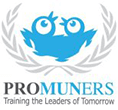Model UN
Model United Nations (Model UN or MUN for short) is pretty much what it sounds like – a simulation of the United Nations that imitates the work methods of the UN’s counsels and committees. During a Model UN, each student takes the role of a foreign diplomat, and must represent his or her country in the various UN bodies.
Using diplomacy and communication skills, the students set out to tackle world problems, while at the same time each student will have to negotiate a resolution that serves his or her country’s best interest. To do so, the students need to research their represented country, and be ready to debate, discuss, and come up creative solutions to the problems at hand. It’s not always easy, but it’s a lot of fun.
A typical simulation will be one session of one of the bodies of the UN: the General Assembly, the Security Council, the Human Rights Committee, and others. They are a good way for students to learn about global issues and international relations by doing rather than by being lectured. Just being knowledgeable isn’t enough – students will need to implement strategic thinking, ad be aware of their allies, their foes, and the deals the can afford to make. Because of this, participating in a Model UN isn’t just a great way to learn about the political realities of our world, but also a way to gain valuable skills, such as public speaking, negotiation skills, research skills and many, many more.
Model UN actually has a history that precedes the UN itself. During the 1920s, students took parts in simulations of the League of Nations, the UN’s predecessor. After World War II, when the League of Nations was dismantled and the United Nations took its place, League of Nation simulations became Model United Nations. Over the years, more and more students saw the value of participating in a Model UN, and today over 400,000 students from middle schools, high schools, colleges and universities participate in Model UN programs all over the world.
